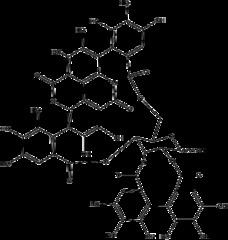Formula C48H28O30 | Molar mass 1,084.71 g/mol | |
 | ||
Punicalagin is an ellagitannin, a type of phenolic compound. It is found in forms alpha and beta in pomegranates (Punica granatum), in Terminalia catappa and Terminalia myriocarpa, and in Combretum molle, the velvet bushwillow, a plant species found in South Africa. These three genera are all Myrtales and the last two are both Combretaceae.
Health effects
Punicalagins are the largest molecule found intact in rat plasma after oral ingestion and were found to show no toxic effects in rats who were given a 6% diet of punicalagins for 37 days. Punicalagins are also found to be the major component responsible for pomegranate juice's antioxidant activity.
Punicalagin is water-soluble and has high bioavailability. They are known to hydrolyze into smaller phenolic compounds such as ellagic acid in vivo where one potential mechanism is hydrolysis across the mitochondrial membrane of cultured human colon cells.
It is a highly active carbonic anhydrase inhibitor.
